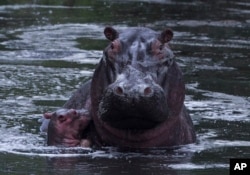Drought is hurting eastern Africa's parks and game reserves, as well as the creatures that reside in them. The Kenya Wildlife Service says dozens of animals have already died because of the lack of water.
Last month, the government declared the drought a national disaster.
Kenya Wildlife Service spokesman Paul Gathitu says lack of water and grazing land has pushed some animals into human settlements, increasing the risk of human-wildlife conflict.
"We've had impacts on wildlife, particularly outside not in the protected areas — Ijara was the first area we noticed," Gathitu said. "Next to Boni forest, there were some dams which dried up and forced a number of animals to go seeking water and struggling to access water. We've lost five buffaloes who were stuck in the mud in that place."
The wildlife agency says 15 hippos have died in Lake Kenyatta, Lamu County.
Lack of preparation
Kahindi Lekalhaile of the Africa Network for Animal Welfare blames a lack of preparation for the suffering and death of wildlife.
"What we are seeing, the effects of drought are being made worse by ignorance, poverty and desperation by ignorant people who actually would have supported the wildlife as the wildlife moves out to look for pastures and water," Kahindi said. "So the drought will always be with us. It's how we manage drought. Wildlife is suffering as a result of us not preparing for drought and us not managing our resources properly."
The wild animals attract millions of dollars in tourist revenue every year. The tourism industry employs more than 200,000 people, and is the leading foreign exchange earner for Kenya after agriculture.
Water supply
Gathitu says his agency is digging more wells in an effort to supply water to the animals.
"We work together with organizations like Big Life, and we provide water to the schools," Gathitu said. "So the communities get water away from the field, where they would have encountered wildlife. In a place like Lamu, we supplied water to those dams."
Wild animals in Kenya already face constant threats from poachers and from people living around the conservation areas. The Department of Resource Surveys and Remote Sensing says Kenya has lost 68 percent of its wildlife in the last four decades.









